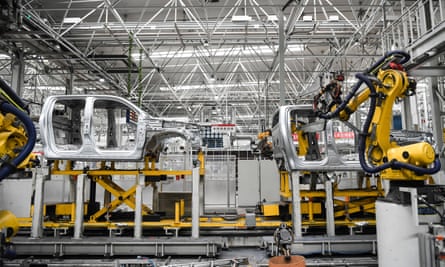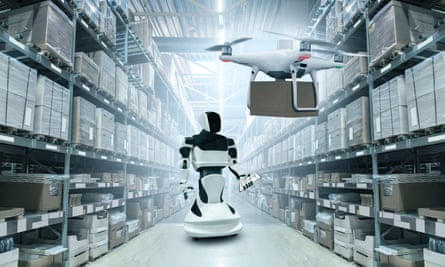Economy
How AI is changing every corner of the economy
|
|
The high profile race to enhance their search products has underscored the importance of artificial intelligence to Google and Microsoft – and the rest of the economy, too. Two of the world’s largest tech companies announced plans for AI-enhanced search this month, ratcheting up a tussle for supremacy in the artificial intelligence space. However, the debut of Google’s new chatbot, Bard, was scuppered when an error appeared, knocking $163bn (£137bn) off the parent company Alphabet’s share price. The stock’s plunge showed how crucial investors think AI could be to Google’s future.
However, the increasing prominence of AI has implications for every corner of the economy. From retail to transport, here’s how AI promises to usher in a wave of change across industries.
Farming
Monitoring weather patterns, managing pests and disease, working out the need for extra irrigation, or even which crops to grow where: many farmers believe agriculture is fertile ground for artificial intelligence.
Many food producers are using AI to collect and analyse data in their efforts to improve productivity and profitability.
AI’s capacity for combining and analysing large datasets is already supplying farmers with real-time information on how to improve the health of their crops and increase yields. Drones and in-ground sensors can play a role in observing growing crops and soil conditions across hundreds of acres of land, including checking whether they need more water, fertiliser or herbicide and whether they are being affected by disease or destroyed by animals.
Ali Capper, who grows apples and hops at her family farm on the border of Herefordshire and Worcestershire, has invested in new technology, including automated orchard sprayers, to use alongside the digital soil mapping she has employed since 2017.


“Many agri-tech innovations will help us to be kinder to the farmed environment as well as more efficient and profitable,” Capper said.
In the face of labour shortages, especially acute since Brexit, farmers have long hoped that advances in robotics – “agribots” – will help to make sure crops get picked on time. A lack of workers led to £60m of food wasted in 2022 alone, according to the National Farmers’ Union.
While four-armed robots, designed for the delicate work of picking soft fruits, are being developed, robots with the dexterity of the human hand, capable of picking at speed without damaging fruit such as raspberries, may be a decade away from widespread use. Nonetheless, automation has already changed some of the most laborious jobs in farming, from drilling seeds to spraying and watering crops. Joanna Partridge
News media
Media companies have embraced machine learning to boost subscriptions and advertising and to help make decisions about what stories to promote.
News organisations are hiring data scientists on six-figure salaries to pull together data to track customers and guide them towards particular products, while also providing workers with tools to take the grunt work out of finding and writing stories.
Lisa Gibbs, the director of news partnerships at the Associated Press, said in a London School of Economics study that her organisation could “find news faster and break news faster” with the aid of AI.
Media organisations are using data analysts to create targeted content that generates higher subscriptions and advertising revenues.
Jane Barrett, the global news editor in Reuters’ media strategy unit, told the LSE: “AI will help us get exactly the right content to the right person.” Phillip Inman
Energy
There are possible AI applications in every corner of the energy
industry: from predicting and identifying faults at power plants to
using weather forecasts to plan offshore windfarm projects.
With tight margins in a sector where almost 30 companies have gone bust during the energy crisis, retail energy suppliers are expected to increase the use of AI to cut down call times. Chatbots are used to ask basic questions before customers speak to a human adviser.
Ultimately, suppliers envisage AI will play a central role in future “smart grids”, allowing supply and demand to be more closely aligned, with a new generation of devices from smart meters and electric vehicles to solar panels and heat pumps able to improve efficiency. Jobs for engineers, meter readers and supply analysts are most under threat.
AI is also valuable to track carbon emissions. Boston Consulting Group has estimated that applying AI to multinational companies’ sustainability plans could be worth $1.3tn to $2.6tn through additional revenues and cost savings by 2030. Late last year, the government launched a £1.5m programme to study the use of AI to reduce the UK’s carbon emissions. Alex Lawson
Manufacturing
Manufacturing veterans know all too well how automation can sweep through an industry. In 2019, the UK’s Office for National Statistics said almost two-thirds of metalworking machine operatives were at risk.


Part of the automation drive is for efficiency. Machine learning algorithms are already being deployed on the burgeoning piles of data produced within big factories for “predictive maintenance” – replacing parts before they fail and potentially requiring fewer technicians.
But the rapid rise of generative artificial intelligence suggests it will not only be people on factory lines who will be affected. Generative AI is already being used to design products much more quickly, test them virtually as a “digital twin”, and manufacture them much more quickly. Combined with innovations such as 3D printing, this could lower development costs dramatically and would require fewer engineers in aerospace, automotive and consumer electronics.
One logical end is something like the Star Trek replicator, a bot that designs and makes whatever its user desires from a text prompt – without human involvement. Jasper Jolly
Government
Running the country means the government collects vast amounts of personal and business data, all of which could be plugged into artificial intelligence and machine learning systems to improve the efficiency of policymaking and delivery of services. Everything from bin collections, call centres and analysis of data to prioritise spending could be targeted for improvement. However, it is not without challenges and controversy – not least for how algorithms are held to account.
The former head of the civil service, Mark Sedwill, has said greater use of AI and automation will probably lead to a reduction in headcount.
Some councils are building computer models using personal data to help predict child abuse and intervene before it can happen, while Blackpool council is using AI-powered satellite images to help fix potholes.
after newsletter promotion
There is concern in government that AI systems can build in human biases, risking the perpetuation of stereotypes and discrimination. Meanwhile, relying on computer models has stoked fear in the past that some public priorities are overlooked, including investment in the north of England and green projects.
More use of AI could improve efficiency but authorities will need to carefully check its effects. As the postwar US president Harry Truman said: “When you have an efficient government, you have a dictatorship.” Richard Partington
Transport
Transport workers have stubbornly held on to their jobs since the first driverless trains were tested on the tube – a development that was met with “Robots take over” headlines six decades ago. However, they are still regarded as most vulnerable in the long term, according to a 2021 report by PwC for the business department forecasting that proportionately the biggest job losses in the next 20 years would come in the transport sector.
Nonetheless, drivers are far from expendable, and are demanding high salaries whether operating HGVs, buses or trains – even as the first autonomous buses are trialled in Scotland and Milton Keynes. Recent dreams of imminent robotaxis have yet to become widespread reality, and Uber says its London drivers earn £34 an hour. Pilotless planes are technically possible, although few might fancy them after Boeing’s software-led 737 Max disasters.

Transport for London uses AI to help traffic flow and forecast disruption, while train operators have used simulators or digital twins to check train paths, platforms and timetables. The Rail Safety and Standards Board is working with academics to use machine learning from high-resolution video to tackle leaves on the line. Similar AI and video projects in Australia could teach driverless trains to recognise a green light – or whether the movement on a remote track is an encroaching human or a nearby kangaroo.
But the next iterations of AI could be profoundly political, as the current rail dispute in Great Britain underlines. Network Rail is hoping to shed more than 1,000 jobs, arguing that automation could create a more efficient and safe inspection regime by using data to predict faults. Gwyn Topham
Financial services
The financial services sector is at greater risk of job losses from AI than other sectors, according to government forecasts, but experts say this is partly a matter of catch-up.
“Other industries have already made these cuts,” said Sarah Kocianski, an independent fintech consultant.
For example, banks and wealth managers will need fewer staff to onboard new clients as they automate more of their customer background checks and will rely more heavily on AI to detect and flag potential fraud and money-laundering risks.
They will also be able to feed new guidelines from regulators into those machine learning programmes, to flag any potential breaches or shortfalls in the company’s systems, rather than relying on humans to conduct an initial review.
But these systems will still require human oversight, not only to build and programme the technology but also to conduct additional checks and sort out more complex problems.
“A critical risk is that firms succumb to the temptation to trust AI to make smarter lending or insurance decisions without understanding the reasoning process, and over-rely on the AI system without properly stress-testing its fitness for purpose,” said Karishma Brahmbhatt, a data and technology lawyer at Allen & Overy.
Alongside booming demand for tech staff to build and monitor AI programmes, firms will be competing for higher-skilled staff who can do forensic work if they suspect fraud or error, or provide bespoke support to customers. “You need more tailored people but you need fewer people,” Kocianski said. Kalyeena Makortoff
Retail
Almost a third of retail jobs could be displaced by technology by 2030 compared with 2017 levels, as automated tills, warehouse robotics and AI-based planning tools affect the UK’s biggest employer.


The most obvious change to any shopper is the rise in the use of self-checkouts and self-scanning systems in supermarkets in the last five years. Change was supercharged by the pandemic when labour became more expensive and difficult to find while shoppers became wary of interactions with staff.
Analysts at the advisory firm McKinsey have predicted that the number of cashiers could almost halve between 2017 and 2030 as these technologies are rolled out. Bryan Roberts at the industry body IGD said the majority of sales in most UK supermarkets are now rung up on self-scanning or automated tills.
The rise of labour costs has also led non-food retailers to give the technology a go. The Japanese-owned clothing chain Uniqlo introduced a system linked to radio frequency identification tags a few years ago.
The next step is the checkout-free store, led by Amazon Fresh, where cameras and shelf sensors mean that shoppers’ purchases are automatically registered on an app on their phone enabling them to just walk out and pay later.
Technology doesn’t stop at the till. Retailers are experimenting with robotic or AI-powered systems to spot gaps on shelves – with Marks & Spencer trialling a system that uses fixed cameras. Others have experimented with Dalek-type machines that cruise up and down the aisles.
Electronic labels on shelves, so prices can be changed automatically from head office, alongside AI-led technology to guide buying decisions and more robotics to pick and pack products in warehouses will also affect thousands of jobs. Sarah Butler





Economy
What to read about India's economy – The Economist


AS INDIA GOES to the polls, Narendra Modi, the prime minister, can boast that the world’s largest election is taking place in its fastest-growing major economy. India’s GDP, at $3.5trn, is now the fifth biggest in the world—larger than that of Britain, its former colonial ruler. The government is investing heavily in roads, railways, ports, energy and digital infrastructure. Many multinational companies, pursuing a “China plus one” strategy to diversify their supply chains, are eyeing India as the unnamed “one”. This economic momentum will surely help Mr Modi win a third term. By the time he finishes it in another five years or so, India’s GDP might reach $6trn, according to some independent forecasts, making it the third-biggest economy in the world.
But India is prone to premature triumphalism. It has enjoyed such moments of optimism in the past and squandered them. Its economic record, like many of its roads, is marked by potholes. Its people remain woefully underemployed. Although its population recently overtook China’s, its labour force is only 76% the size. (The percentage of women taking part in the workforce is about the same as in Saudi Arabia.) Investment by private firms is still a smaller share of GDP than it was before the global financial crisis of 2008. When Mr Modi took office, India’s income per person was only a fifth of China’s (at market exchange rates). It remains the same fraction today. These six books help to chart India’s circuitous economic journey and assess Mr Modi’s mixed economic record.
Breaking the Mould: Reimagining India’s Economic Future. By Raghuram Rajan and Rohit Lamba. Penguin Business; 336 pages; $49.99
Before Mr Modi came to office, India was an unhappy member of the “fragile five” group of emerging markets. Its escape from this club owes a lot to Raghuram Rajan, who led the country’s central bank from 2013 to 2016. In this book he and Mr Lamba of Pennsylvania State University express impatience with warring narratives of “unmitigated” optimism and pessimism about India’s economy. They make the provocative argument that India should not aspire to be a manufacturing powerhouse like China (a “faux China” as they put it), both because India is inherently different and because the world has changed. India’s land is harder to expropriate and its labour harder to exploit. Technological advances have also made services easier to export and manufacturing a less plentiful source of jobs. Their book is sprinkled with pen portraits of the kind of industries they believe can prosper in India, including chip design, remote education—and well-packaged idli batter. Both authors regret India’s turn towards tub-thumping majoritarianism, which they think will ultimately inhibit its creativity and hence its economic prospects. Nonetheless this is a work of mitigated optimism.
New India: Reclaiming the Lost Glory. By Arvind Panagariya. Oxford University Press; 288 pages
This book provides a useful foil for “Breaking the Mould”. Arvind Panagariya took leave from Columbia University to serve as the head of a government think-tank set up by Mr Modi to replace the old Planning Commission. The author is ungrudging in his praise for the prime minister and unsparing in his disdain for the Congress-led government he swept aside. Mr Panagariya also retains faith in the potential of labour-intensive manufacturing to create the jobs India so desperately needs. The country, he argues in a phrase borrowed from Mao’s China, must walk on two legs—manufacturing and services. To do that, it should streamline its labour laws, keep the rupee competitive and rationalise tariffs at 7% or so. The book adds a “miscellany” of other reforms (including raising the inflation target, auctioning unused government land and removing price floors for crops) that would keep Mr Modi busy no matter how long he stays in office.
The Lost Decade 2008-18: How India’s Growth Story Devolved into Growth without a Story. By Puja Mehra. Ebury Press; 360 pages; $21
Both Mr Rajan and Mr Panagariya make an appearance in this well-reported account of India’s economic policymaking from 2008 to 2018. Ms Mehra, a financial journalist, describes the corruption and misjudgments of the previous government and the disappointments of Mr Modi’s first term. The prime minister was exquisitely attentive to political threats but complacent about more imminent economic dangers. His government was, for example, slow to stump up the money required by India’s public-sector banks after Mr Rajan and others exposed the true scale of their bad loans to India’s corporate titans. One civil servant recounts long, dull meetings in which Mr Modi monitored his piecemeal welfare schemes, even as deeper reforms languished. “The only thing to do was to polish off all the peanuts and chana.”
The Billionaire Raj: A Journey Through India’s New Gilded Age. By James Crabtree. Oneworld Publications; 416 pages; $7.97
For a closer look at those corporate titans, turn to the “Billionaire Raj” by James Crabtree, formerly of the Financial Times. The prologue describes the mysterious late-night crash of an Aston Martin supercar, registered to a subsidiary of Reliance, a conglomerate owned by Mukesh Ambani, India’s richest man. Rumours swirl about who was behind the wheel, even after an employee turns himself in. The police tell Mr Crabtree that the car has been impounded for tests. But he spots it abandoned on the kerb outside the police station, hidden under a plastic sheet. It was still there months later. Mr Crabtree goes on to lift the covers on the achievements, follies and influence of India’s other “Bollygarchs”. They include Vijay Mallya, the former owner of Kingfisher beer and airlines. Once known as the King of Good Times, he moved to Britain from where he faces extradition for financial crimes. Mr Crabtree meets him in drizzly London, where the chastened hedonist is only “modestly late” for the interview. Only once do the author’s journalistic instincts fail him. He receives an invitation to the wedding of the son of Gautam Adani. The controversial billionaire is known for his close proximity to Mr Modi and his equally close acquaintance with jaw-dropping levels of debt. The bash might have warranted its own chapter in this book. But Mr Crabtree, unaccustomed to wedding invitations from strangers, declines to attend.
Unequal: Why India Lags Behind its Neighbours. By Swati Narayan. Context; 370 pages; $35.99
Far from the bling of the Bollygarchs or the ministries of Delhi, Swati Narayan’s book draw son her sociological fieldwork in the villages of India’s south and its borderlands with Bangladesh and Nepal. She tackles “the South Asian enigma”: why have some of India’s poorer neighbours (and some of its southern states) surpassed India’s heartland on so many social indicators, including health, education, nutrition and sanitation. Girls in Bangladesh have a longer life expectancy than in India, and fewer of them will be underweight for their age. Her argument is illustrated with a grab-bag of statistics and compelling vignettes: from abandoned clinics in Bihar, birthing centres in Nepal, and well-appointed child-care centres in the southern state of Kerala. In a Bangladeshi border village, farmers laugh at their Indian neighbours who still defecate in the fields. She details the cruel divisions of caste, class, religion and gender that still oppress so many people in India and undermine the common purpose that social progress requires.
How British Rule Changed India’s Economy: The Paradox of the Raj. By Tirthankar Roy. Springer International; 159 pages; $69.99
Many commentators describe the British Empire as a relentless machine for draining India’s wealth. But that may give it too much credit. The Raj was surprisingly small, makeshift and often ineffectual. It relied too heavily on land for its revenues, which rarely exceeded 7% of GDP, points out Tirthankar Roy of the London School of Economics. It spent more on infrastructure and less on luxuries than the Mughal empire that preceded it. But it neglected health care and education. India’s GDP per person barely grew from 1914 to 1947. Mr Roy reveals the great divergence within India that is masked by that damning average. Britain’s “merchant Empire”, committed to globalisation, was good for coastal commerce, but left the countryside poor and stagnant. Unfortunately, for the rural masses, moving from rural areas to the city was never easy. Indeed, some of the social barriers to mobility that Mr Roy lists in this book about India’s economic past still loom large in books about its future.
Also try
We regularly publish special reports on India, the latest, in April 2024, focuses on the economy. Please also subscribe to our weekly Essential India newsletter, to make sure you don’t miss any of our comprehensive coverage of the country’s economy, politics and society.
Economy
The Fed's Forecasting Method Looks Increasingly Outdated as Bernanke Pitches an Alternative – Bloomberg


The Federal Reserve is stuck in a mode of forecasting and public communication that looks increasingly limited, especially as the economy keeps delivering surprises.
The issue is not the forecasts themselves, though they’ve frequently been wrong. Rather, it’s that the focus on a central projection — such as three interest-rate cuts in 2024 — in an economy still undergoing post-pandemic tremors fails to communicate much about the plausible range of outcomes. The outlook for rates presented just last month now appears outdated amid a fresh wave of inflation.
Economy
Slump in Coal Production Drags Down Poland’s Economic Recovery
|
|


A 26% plunge in coal mining weighed on Poland’s industrial output in March 2024, casting a shadow over the expectations that the biggest emerging-market economy in Europe would grow by the expected 3% this year.
Coal mining output slumped by 25.9% year-over-year in March, contributing to a 6% decline in Poland’s industrial production last month, government data showed on Monday. This was the steepest decline in Poland’s industrial output since April 2023, per Bloomberg’s estimates. It was also much worse than expectations of a 2.2% drop in industrial production.
The steep drop in the Polish industry last month raises questions about whether the EU’s most coal-dependent economy would manage to see a 3% rebound in its economy this year, as the central bank and the finance ministry expect.
Still, it’s too early into the year to raise flags about Poland’s economy, Grzegorz Maliszewski, chief economist at Bank Millennium, told Reuters.
“I wouldn’t radically change my expectations here, because there are many reasons to expect a continuation of economic recovery, as domestic demand will increase and the economic situation in Germany is also improving,” Maliszewski said.
Meanwhile, Poland’s new government has signaled it would be looking to set an end date for using coal for power generation, a senior government official said.
“Only with an end date we can plan and only with an end date industry can plan, people can plan. So yes, absolutely, we will be looking to set an end date,” Urszula Zielinska, the Secretary of State at the Ministry of Climate and Environment, said in Brussels earlier this year.
Last year, renewables led by onshore wind generated a record share of Poland’s electricity—26%, but coal continued to dominate the power generating mix, per the German research organization Fraunhofer Society.
Poland’s power grid operator said last month that it would spend $16 billion on upgrading and expanding its power grid to accommodate additional renewable and nuclear capacity.





-
Business14 hours ago
Honda to build electric vehicles and battery plant in Ontario, sources say – Global News
-



 Science15 hours ago
Science15 hours agoWill We Know if TRAPPIST-1e has Life? – Universe Today
-
Investment18 hours ago
Down 80%, Is Carnival Stock a Once-in-a-Generation Investment Opportunity?
-



 Health14 hours ago
Health14 hours agoSimcoe-Muskoka health unit urges residents to get immunized
-



 Health11 hours ago
Health11 hours agoSee how chicken farmers are trying to stop the spread of bird flu – Fox 46 Charlotte
-
News19 hours ago
Honda expected to announce multi-billion dollar deal to assemble EVs in Ontario
-



 Science20 hours ago
Science20 hours agoWatch The World’s First Flying Canoe Take Off
-



 Investment13 hours ago
Investment13 hours agoOwn a cottage or investment property? Here's how to navigate the new capital gains tax changes – The Globe and Mail





